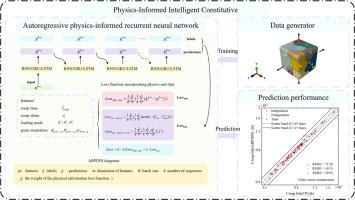考虑多晶微观结构演变的智能本构方法预测蠕变
IF 12.8
1区 材料科学
Q1 ENGINEERING, MECHANICAL
引用次数: 0
摘要
晶体塑性有限元(CPFE)建模已经成为一种领先的细观建模方法,它将完全分解的微观结构和基于物理的微尺度变形机制集成到晶体材料的本构建模中。然而,这种方法需要大量的计算资源,这限制了其在极端载荷(如蠕变)下复杂多晶微结构的应用。本研究提出了一种基于物理的智能本构模型,以加速多晶组织蠕变响应和寿命的模拟,并将其应用于镍合金Inconel 617。该模型使用CPFE模拟生成的物理约束和蠕变数据进行训练,这些数据明确考虑了位错滑动和攀爬、晶界滑动和打开以及各种晶粒取向之间的相互作用。为了解决与多晶代表性体积元相关的计算挑战和数据冗余问题,提出并研究了两种降维方法,即主成分分析和均质织物张量凝聚。然后,以初始状态和加载条件为输入,以蠕变时间、蠕变应变演化和晶粒取向为输出,建立了自回归的物理信息神经网络模型。利用CPFE建模数据对模型进行训练,预测了Inconel 617的高温蠕变行为。后者表现出更好的预测性能,与使用CPFE的直接数值模拟相比,效率提高了6个数量级。将该模型进一步应用于智能本构和织构描述的快速构建研究,提高了预测蠕变行为的效率和准确性。利用该模型进一步研究了纹理描述的效果。织物张量是一种有效的微观结构指标。本文章由计算机程序翻译,如有差异,请以英文原文为准。

A Physics-Informed Intelligent Constitutive Approach for Predicting Creep Deformation Considering Polycrystalline Microstructure Evolution
Crystal plasticity finite element (CPFE) modeling has emerged as a leading mesoscopic modeling approach by integrating fully resolved microstructures and physics-based microscale deformation mechanisms into the constitutive modeling of crystal materials. However, this approach demands substantial computational resources, which limits its application for complex polycrystalline microstructures subjected to extreme loadings such as creep. In this study, a physics-informed intelligent constitutive model is proposed to accelerate the simulation of the creep response and life of polycrystalline microstructures and applied to nickel alloy Inconel 617. The model is trained with physical constraints and creep data generated by CPFE simulations that explicitly consider the interaction between dislocation glide and climb, grain boundary sliding and opening, and various grain orientations. To address the computational challenges and data redundancy issues associated with polycrystalline representative volume elements, two dimensionality reduction methods, namely principal component analysis and homogenized fabric tensor condensation, are proposed and studied. An autoregressive physics-informed neural network model is then developed using initial state and loading conditions as input, while creep time, evolution of creep strain, and grain orientation are the outputs. The model is trained using CPFE modeling data to predict the high-temperature creep behavior of Inconel 617. The latter demonstrates better predictive performance and delivers six orders of higher efficiency compared to direct numerical simulation using CPFE. The developed model is further used to study the rapid construction of intelligent constitutive and texture description, which shows improved efficiency and accuracy in predicting the creep behavior. The effect of texture description is further studied by using the proposed model. The fabric tensor is demonstrated to be an effective microstructural indicator.
求助全文
通过发布文献求助,成功后即可免费获取论文全文。
去求助
来源期刊

International Journal of Plasticity
工程技术-材料科学:综合
CiteScore
15.30
自引率
26.50%
发文量
256
审稿时长
46 days
期刊介绍:
International Journal of Plasticity aims to present original research encompassing all facets of plastic deformation, damage, and fracture behavior in both isotropic and anisotropic solids. This includes exploring the thermodynamics of plasticity and fracture, continuum theory, and macroscopic as well as microscopic phenomena.
Topics of interest span the plastic behavior of single crystals and polycrystalline metals, ceramics, rocks, soils, composites, nanocrystalline and microelectronics materials, shape memory alloys, ferroelectric ceramics, thin films, and polymers. Additionally, the journal covers plasticity aspects of failure and fracture mechanics. Contributions involving significant experimental, numerical, or theoretical advancements that enhance the understanding of the plastic behavior of solids are particularly valued. Papers addressing the modeling of finite nonlinear elastic deformation, bearing similarities to the modeling of plastic deformation, are also welcomed.
 求助内容:
求助内容: 应助结果提醒方式:
应助结果提醒方式:


